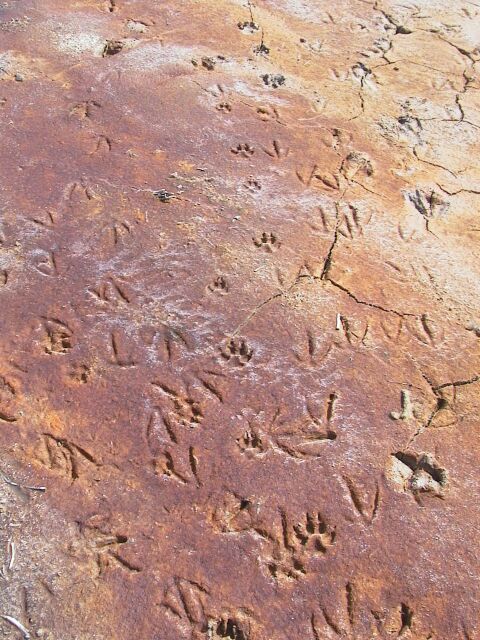 Photo by Dennis Deck
Photo by Dennis DeckThis photo was taken in Yellowstone National Park on the flats at Beaver Lake in early August. Weeks before the lake mud had slowly dried in the sun capturing a variety of tracks.
 Photo by Dennis Deck
Photo by Dennis Deck
Examine the photo carefully to see how many stories are captured in the mud. Pay particular attention to gaits. Can you identify each animal and what it is doing?

Clearly several stories are captured in this photo. The most striking is the galloping stride of a coyote moving from the bottom of the picture toward the top. Notice the splay and larger size of the front feet compared to the hind feet. This coyote lead with its right front foot, followed by left hind, left front, right hind. This combination suggests a lope (slow gallop). The intergroup distance (distance between each set of tracks) is quite small. Some consider the lope more energy efficient than faster trots. (For more information about gaits, see Jim Halfpenny's classic book A Field Guide to Mammal Tracking in North America.)
Also notice that the coyote tracks are aligned diagonally across the direction of travel. This suggests the animal was oriented to the right so that the hind foot registers to the left of the front foot.
A second coyote passed through the lower left hand third of the photo. It is hard to make out the gait from the photo but it appears to be a fast side trot where the hind foot oversteps to the right of the front foot.
A flock of Canada geese spent some time here, with several individuals walking back and forth with a pigeon toed gait. The track is fairly large relative to the coyote. Webbing between the toes sometimes shows.
The bright colors on the surface of the mud in this photo are caused by bacteria that thrive in the hot water that bubbles to the surface in small springs around the lake. Similar displays can be seen in the geyser basins in several parts of Yellowstone.